The collection of artwork housed by a church, abbey or cathedral can be diverse in both age and medium. Some of the most contrasting pieces are statues, from mediaeval wooden carvings to modern fibreglass figures.
 Above: from left to right, a stone apostle from 1440-50, ‘The Miracle of the Palm Tree’ from 1490-1510, Virgin and Child from 1425-30 and a wooden statue of Saint Bridget of Sweden from 1470
Above: from left to right, a stone apostle from 1440-50, ‘The Miracle of the Palm Tree’ from 1490-1510, Virgin and Child from 1425-30 and a wooden statue of Saint Bridget of Sweden from 1470
Our team consists of experts from a wide range of conservation disciplines, including historic and contemporary materials. This article will cover care advice for different types of religious sculpture and the restoration that is possible following damage.
 Above: from left to right, a 19th century Jean-Joseph Carriès sculpture, a gilt bronze statue of Victory from 1914, a 15th century sculpture of Saint Margaret of Antioch and 16th century Spanish statue of Saint Michael
Above: from left to right, a 19th century Jean-Joseph Carriès sculpture, a gilt bronze statue of Victory from 1914, a 15th century sculpture of Saint Margaret of Antioch and 16th century Spanish statue of Saint Michael
Stone sculpture
Stone sculptures situated inside a building can last for centuries if they are in a stable condition and environment. When a piece is damaged it is usually through accidental circumstances. Historic damage may have also taken place in times of reformation and religious upheaval.
 Above: from left to right, a limestone statue of Saint James the Greater from 1450-75, the head of a king from 1220-30, a painted stone Virgin and Child from 1300-30 and an alabaster sculpture of a mourner from 1453
Above: from left to right, a limestone statue of Saint James the Greater from 1450-75, the head of a king from 1220-30, a painted stone Virgin and Child from 1300-30 and an alabaster sculpture of a mourner from 1453
It is important that broken areas of a stone statue are not repaired using amateur techniques. The application of household glues and adhesives may sink into the pores and create an embedded acidic stain along the breakage, causing a visual disturbance and future instability.
 Above: a French limestone sculpture of the Entombment of Christ, 1515
Above: a French limestone sculpture of the Entombment of Christ, 1515
Stone sculptures should never be cleaned with a liquid and should only be approached by professionals for routine maintenance. When stone statuary is broken, the best course of action is to contact a conservation professional as soon as possible. Our team uses methods and materials that are safe for the ongoing preservation of a statue. If a broken piece is missing or unable to be re-adhered, new pieces can in some circumstances be recreated.
 Above: from left to right, a 16th century shield bearer with the ducal arms of saxony, a 6th century architectural decoration and a painted limestone statue of Saint Barbara
Above: from left to right, a 16th century shield bearer with the ducal arms of saxony, a 6th century architectural decoration and a painted limestone statue of Saint Barbara
Wooden sculpture
Wooden sculptures face far more environmental issues than stone pieces, their wood may have a slight movement over time as the atmosphere changes – leading to a cracked or flaking surface. This is usually the case with statues that have a painted gesso layer. Whilst some of this is natural and may add to the historic appearance of the piece, an unstable surface that is actively deteriorating should be looked at by a conservator to halt any further issues.
 Above: from left to right, an oak statue of Saint Roch from the early 16th century, a painted wooden statue of Saint Anne from 1525, a limewood sculpture of Saint Barbara from 1510 and a reliquary bust of Saint Balbina 1520-30
Above: from left to right, an oak statue of Saint Roch from the early 16th century, a painted wooden statue of Saint Anne from 1525, a limewood sculpture of Saint Barbara from 1510 and a reliquary bust of Saint Balbina 1520-30
Wooden sculptures should be kept in a stable environment to avoid rapid changes in temperature and humidity. When they are cleaned, only a light, soft and dry cloth should be used without pressure to avoid the removal of surface paint or flaking of the structure.
 Above: a detail of a lindenwood sculpture of The Mourning Virgin with polychromy and gilt decoration, early 18th century
Above: a detail of a lindenwood sculpture of The Mourning Virgin with polychromy and gilt decoration, early 18th century
Mediaeval sculptures will always be restored sensitively with a sympathetic approach to their historic appearance. This means that often a full restoration is not in the best interest of the object and instead minimal intervention is used to carefully stabilise areas to prevent loss. If it is necessary, new gesso can be applied to lost areas and the paint can be colour-matched to lessen any visual distraction.
 Above: from left to right, a 16th century walnut statue of Saint Catherine of Alexandria, a mid 18th century angel with a painted and gilded surface, a south Netherlandish Descent from the Cross from the early 16th century, and an oak altar angel from 1275-1300
Above: from left to right, a 16th century walnut statue of Saint Catherine of Alexandria, a mid 18th century angel with a painted and gilded surface, a south Netherlandish Descent from the Cross from the early 16th century, and an oak altar angel from 1275-1300
Marble sculpture
The pure colour of marble can be easily discoloured by age and atmospheric contamination. Whilst some amount of patina may be in keeping with the age of the piece, a constant exposure to candle smoke and incense should be avoided – this is the case with all forms of sculpture, though marble may be the worst affected.
 Above: from left to right, a marble tomb effigy bust from 1381, a relief of Saint Andrew from 1491 and a bust of Cardinal Scipione Borghese from 1631-32
Above: from left to right, a marble tomb effigy bust from 1381, a relief of Saint Andrew from 1491 and a bust of Cardinal Scipione Borghese from 1631-32
Marble pieces may wear down if they are within touching distance of visitors. In some cases, marble sculptures may have an area that is worn down and discoloured by constant contact with hands. In some cases it may be part of the sculptures tradition, but in cases where this appears problematic a sign or barrier should be put up to avoid deterioration.
 Above: an angel sculpted in Lunense marble from Carrara, 1430-35
Above: an angel sculpted in Lunense marble from Carrara, 1430-35
Our ceramics conservator is able to restore broken, discoloured or cracked marble. This is completed sensitively to retain the sculptures historic integrity and artistic value.
 Above: from left to right, pilaster of angels from the parapet of a pulpit 1302-10, parapet tetramorph 1302-10, a South Netherlandish virgin and child 1345, an angel of the annunciation 1370-90, an adoring angel 1395–96, and a virgin and child with gilt details 1340
Above: from left to right, pilaster of angels from the parapet of a pulpit 1302-10, parapet tetramorph 1302-10, a South Netherlandish virgin and child 1345, an angel of the annunciation 1370-90, an adoring angel 1395–96, and a virgin and child with gilt details 1340
Plaster and ceramic sculptures
Sculptures in plaster may become brittle over time, especially in a dry environment. This may lead to loss of stability, paint work or structure. A plaster sculpture should not be cleaned with a liquid solution and care should be taken not to disturb any paint or decorative layer when it is gently dusted with a soft, clean cloth.
 Above: from left to right, porcelain virgin mary by Fulda Pottery and Porcelain Manufactory 1781, a 15th century clay virgin with child, the mourning virgin by Capodimonte Porcelain Manufactory 1744, and a terracotta bust 1390-95
Above: from left to right, porcelain virgin mary by Fulda Pottery and Porcelain Manufactory 1781, a 15th century clay virgin with child, the mourning virgin by Capodimonte Porcelain Manufactory 1744, and a terracotta bust 1390-95
Our conservators have restored many ceramic sculptures and statuettes, including a recent statue of Saint Joseph that had severe flaking and breakages. In this case, it is always important to keep all broken areas – no matter how small – so that they can be restored back into place.
 Above: a statue of St Joseph holding Christ, before and after restoration by our conservator
Above: a statue of St Joseph holding Christ, before and after restoration by our conservator
Metal sculptures
Bronze is a typical material for statues and busts, it may face issues over time from rust and corrosion. Gilt bronze features may also lose their desired patina, leaving the metal below vulnerable to the environment. Our conservation team have previously restored a bronze death mask of Dante, you can find out more about metal sculpture care and the restoration of bronze here.
 Above: an Italian bronze sculpture of Saint John from 1596 and a 17th century bronze cast of Saint Catherine of Siena with oil gilt details
Above: an Italian bronze sculpture of Saint John from 1596 and a 17th century bronze cast of Saint Catherine of Siena with oil gilt details
Fibreglass sculpture
Modern statues may have aspects of fibreglass and other manmade materials. This is often the case with pieces from the mid 20th century onwards. Whilst fibreglass can be long lasting, the painted surfaces of such sculptures may become discoloured, cracked or begin to flake.
Our studio has seen various fibreglass sculptures that have required sensitive cleaning to clear airborne contaminants and pollution. This will be the case with any fibreglass sculptures that have been displayed near candlelight for a number of years. This discolouration should not be cleaned by an amateur, as the wrong use of a cleaning solution may dislodge and remove the painted or varnished surface.
When a modern sculpture appears to be cracking or flaking, our team can use conservation methods to re-adhere the original paint to the surface. This will help the piece to maintain as much of its original appearance as possible. The crack lines or lost areas can then be filled to stabilise the paint layer and gently retouched using appropriate pigments.
How can we help?
If you have a sculpture that may require restoration or preventative conservation treatments, please speak to our helpful team for further advice.
To make contact please email us via [email protected] or call 0207 112 7576

 Above: from left to right, a stone apostle from 1440-50, ‘The Miracle of the Palm Tree’ from 1490-1510, Virgin and Child from 1425-30 and a wooden statue of Saint Bridget of Sweden from 1470
Above: from left to right, a stone apostle from 1440-50, ‘The Miracle of the Palm Tree’ from 1490-1510, Virgin and Child from 1425-30 and a wooden statue of Saint Bridget of Sweden from 1470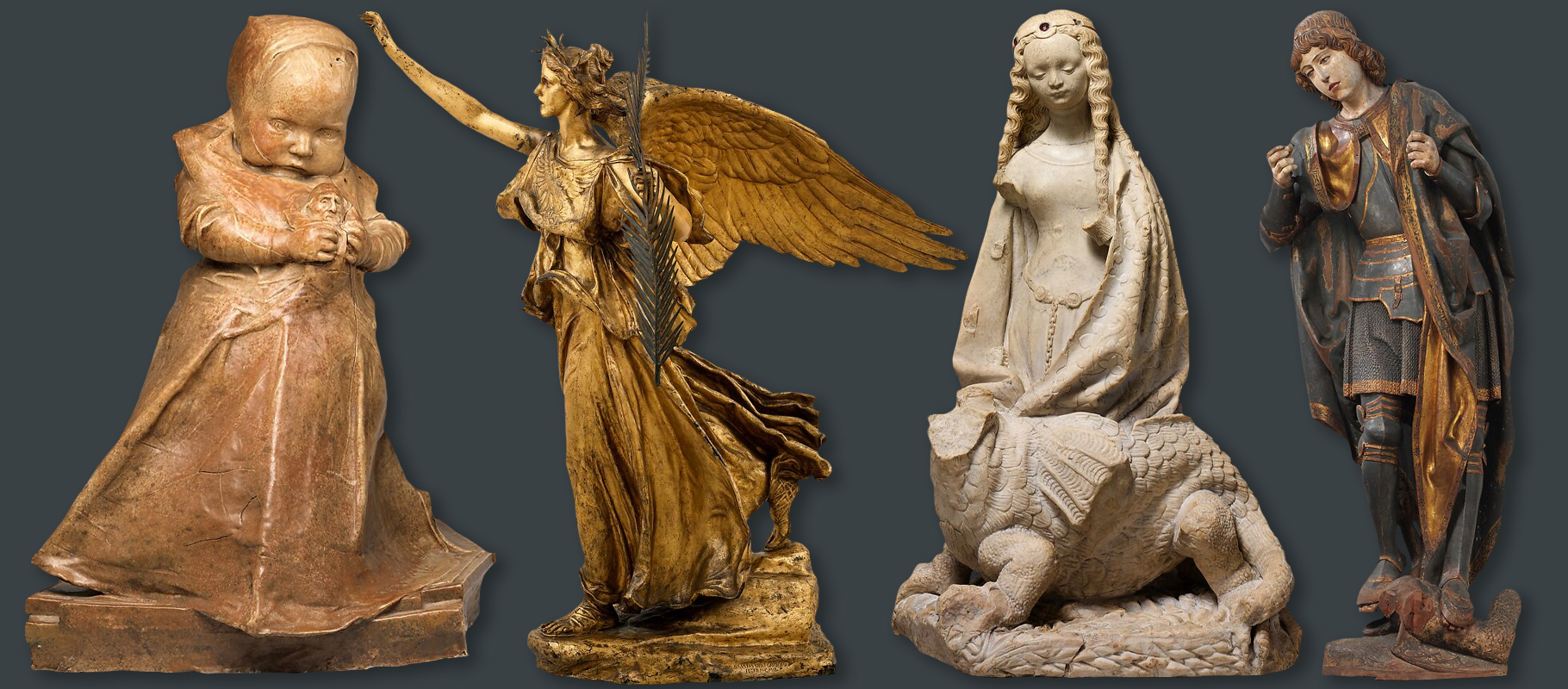 Above: from left to right, a 19th century Jean-Joseph Carriès sculpture, a gilt bronze statue of Victory from 1914, a 15th century sculpture of Saint Margaret of Antioch and 16th century Spanish statue of Saint Michael
Above: from left to right, a 19th century Jean-Joseph Carriès sculpture, a gilt bronze statue of Victory from 1914, a 15th century sculpture of Saint Margaret of Antioch and 16th century Spanish statue of Saint Michael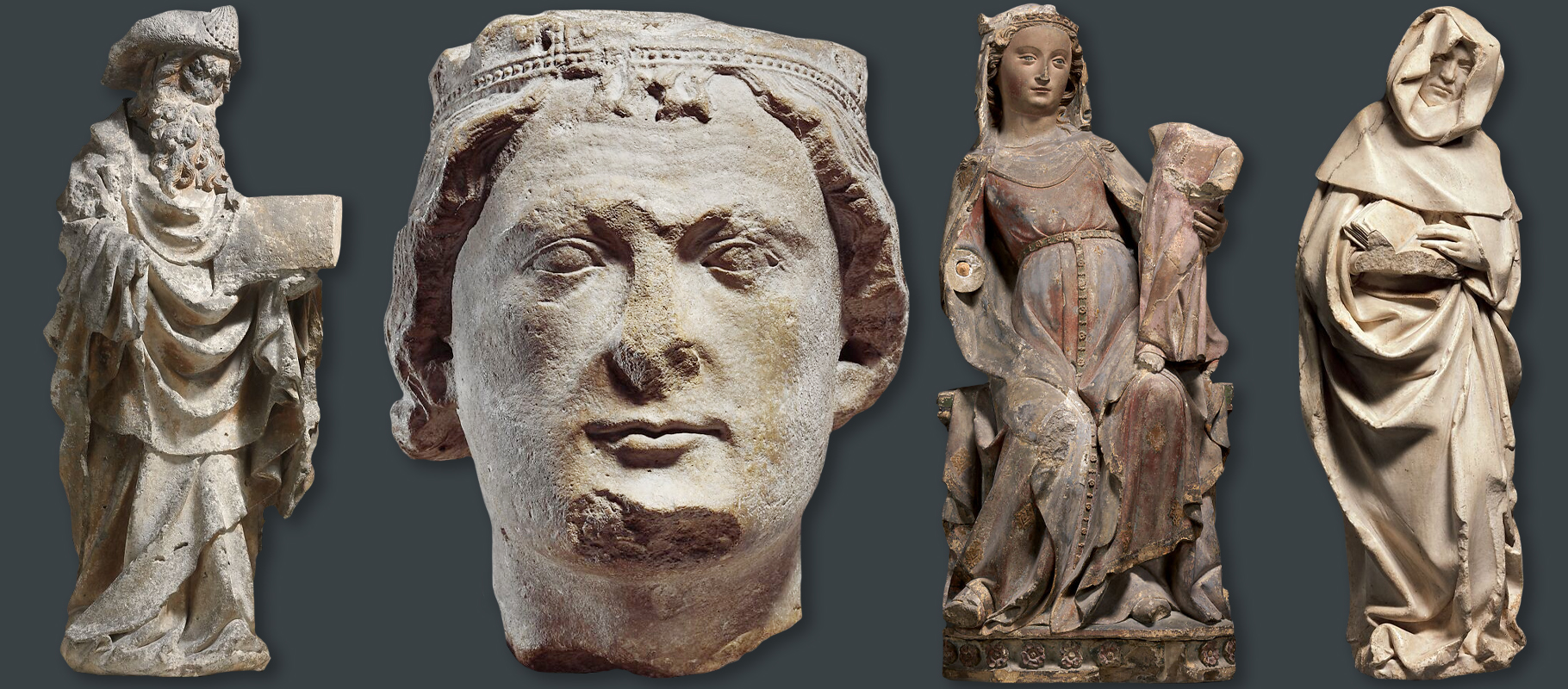 Above: from left to right, a limestone statue of Saint James the Greater from 1450-75, the head of a king from 1220-30, a painted stone Virgin and Child from 1300-30 and an alabaster sculpture of a mourner from 1453
Above: from left to right, a limestone statue of Saint James the Greater from 1450-75, the head of a king from 1220-30, a painted stone Virgin and Child from 1300-30 and an alabaster sculpture of a mourner from 1453 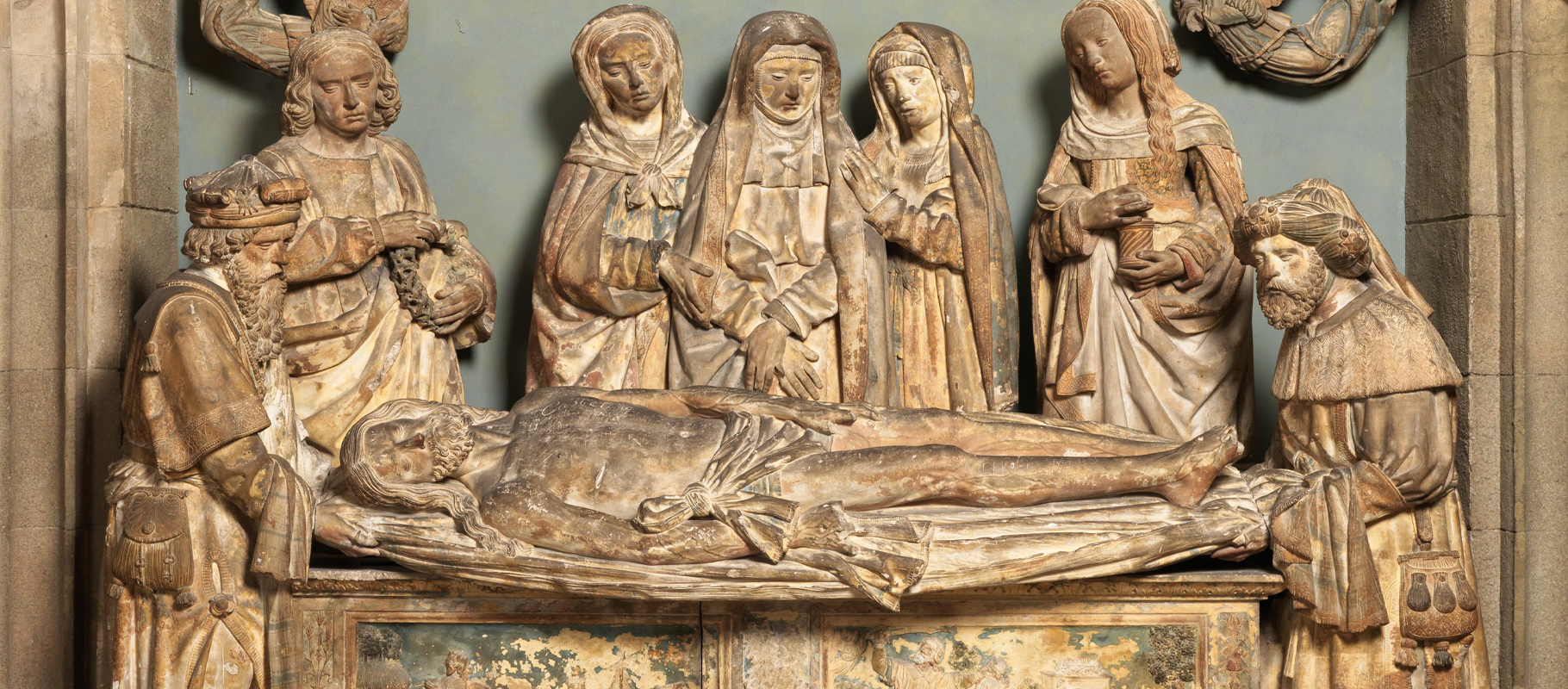 Above: a French limestone sculpture of the Entombment of Christ, 1515
Above: a French limestone sculpture of the Entombment of Christ, 1515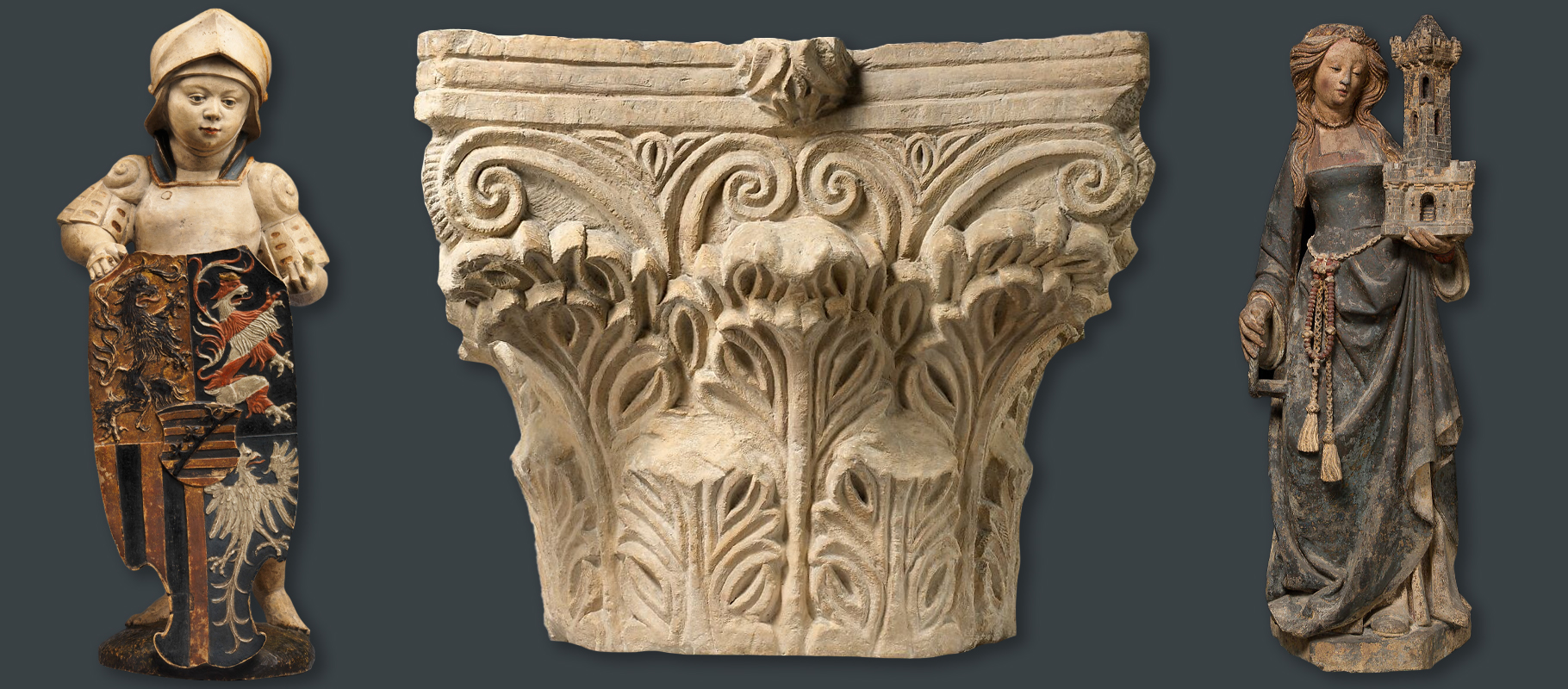 Above: from left to right, a 16th century shield bearer with the ducal arms of saxony, a 6th century architectural decoration and a painted limestone statue of Saint Barbara
Above: from left to right, a 16th century shield bearer with the ducal arms of saxony, a 6th century architectural decoration and a painted limestone statue of Saint Barbara 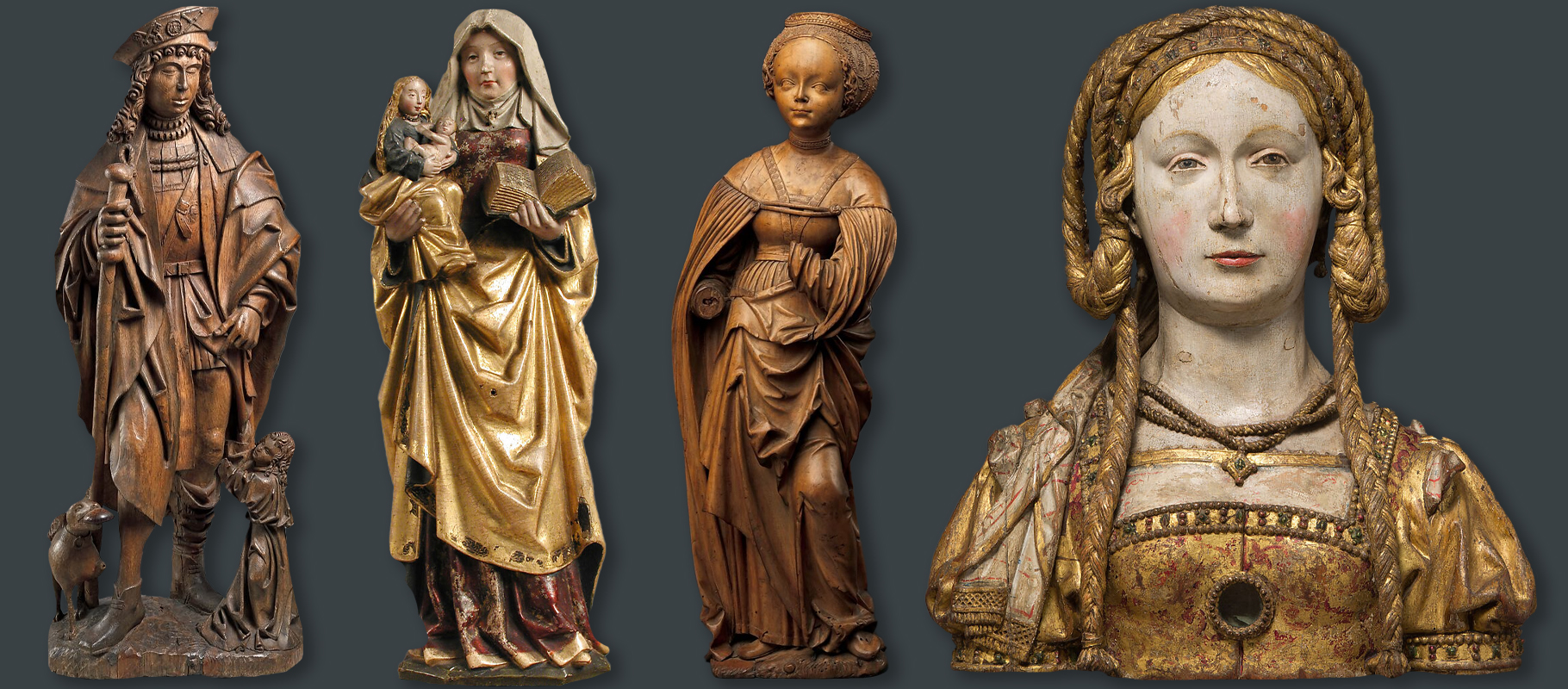 Above: from left to right, an oak statue of Saint Roch from the early 16th century, a painted wooden statue of Saint Anne from 1525, a limewood sculpture of Saint Barbara from 1510 and a reliquary bust of Saint Balbina 1520-30
Above: from left to right, an oak statue of Saint Roch from the early 16th century, a painted wooden statue of Saint Anne from 1525, a limewood sculpture of Saint Barbara from 1510 and a reliquary bust of Saint Balbina 1520-30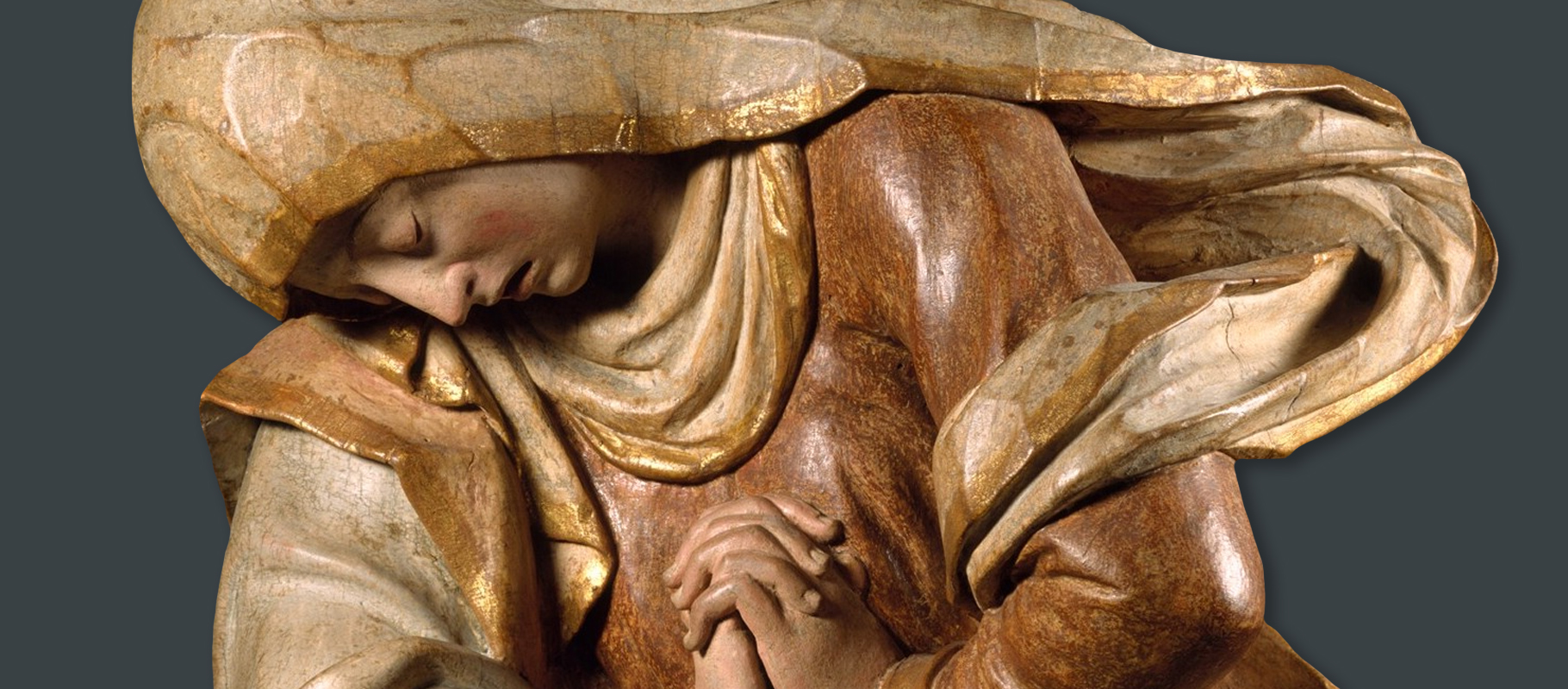 Above: a detail of a lindenwood sculpture of The Mourning Virgin with polychromy and gilt decoration, early 18th century
Above: a detail of a lindenwood sculpture of The Mourning Virgin with polychromy and gilt decoration, early 18th century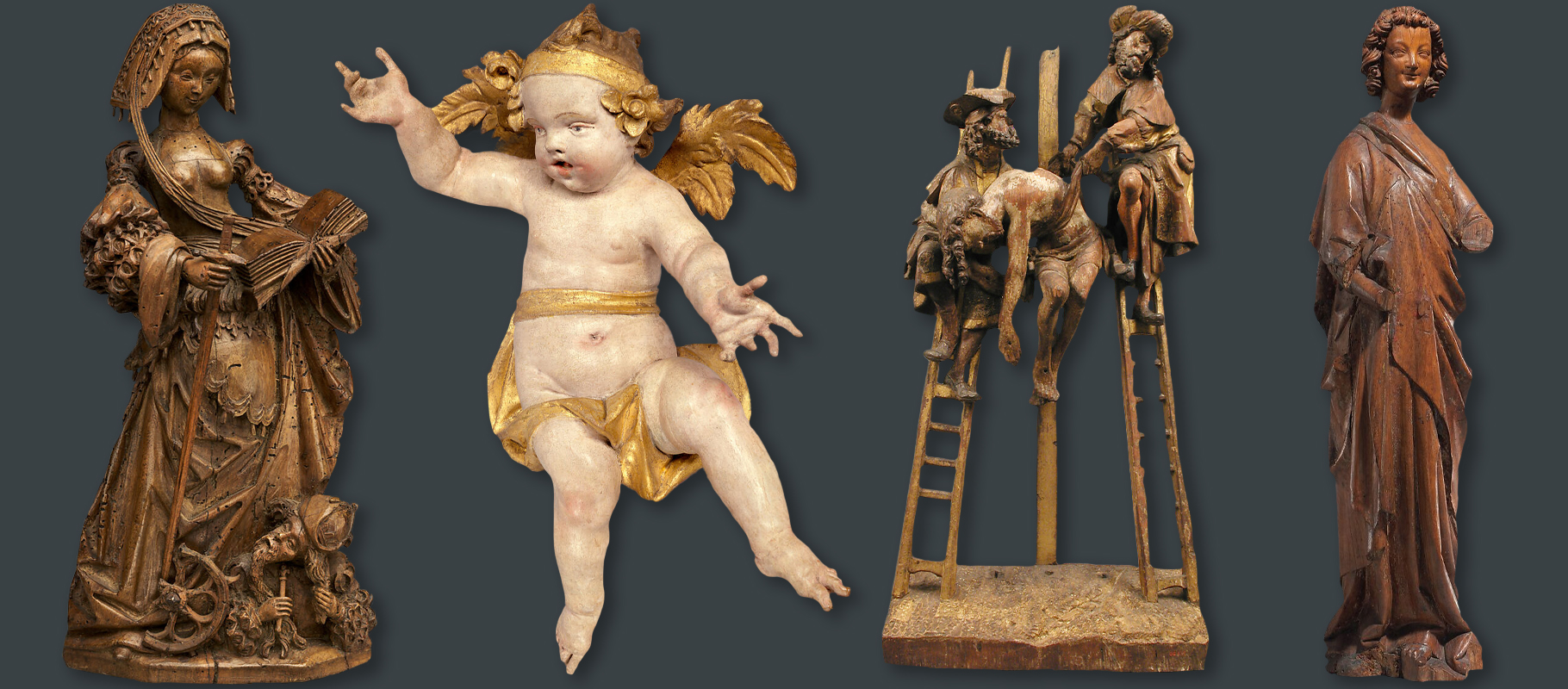 Above: from left to right, a 16th century walnut statue of Saint Catherine of Alexandria, a mid 18th century angel with a painted and gilded surface, a south Netherlandish Descent from the Cross from the early 16th century, and an oak altar angel from 1275-1300
Above: from left to right, a 16th century walnut statue of Saint Catherine of Alexandria, a mid 18th century angel with a painted and gilded surface, a south Netherlandish Descent from the Cross from the early 16th century, and an oak altar angel from 1275-1300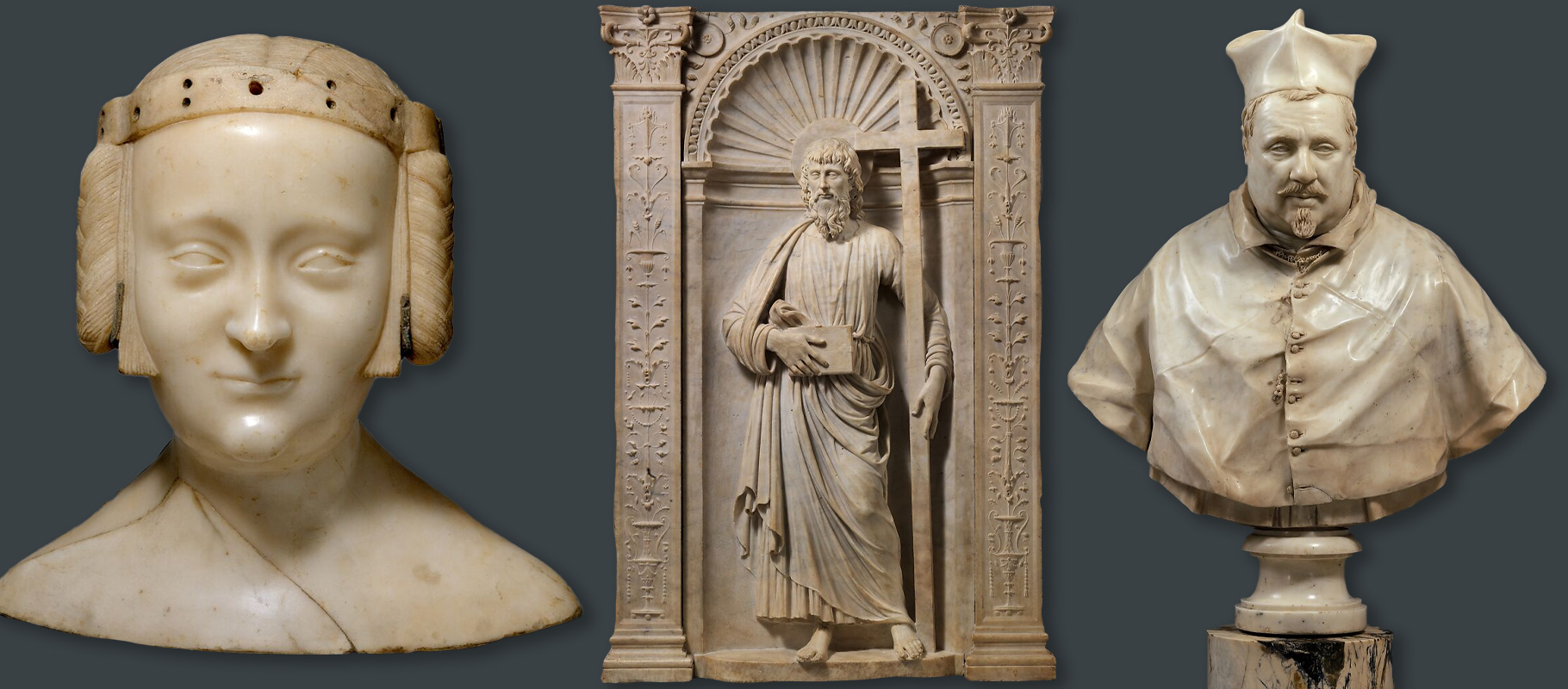 Above: from left to right, a marble tomb effigy bust from 1381, a relief of Saint Andrew from 1491 and a bust of Cardinal Scipione Borghese from 1631-32
Above: from left to right, a marble tomb effigy bust from 1381, a relief of Saint Andrew from 1491 and a bust of Cardinal Scipione Borghese from 1631-32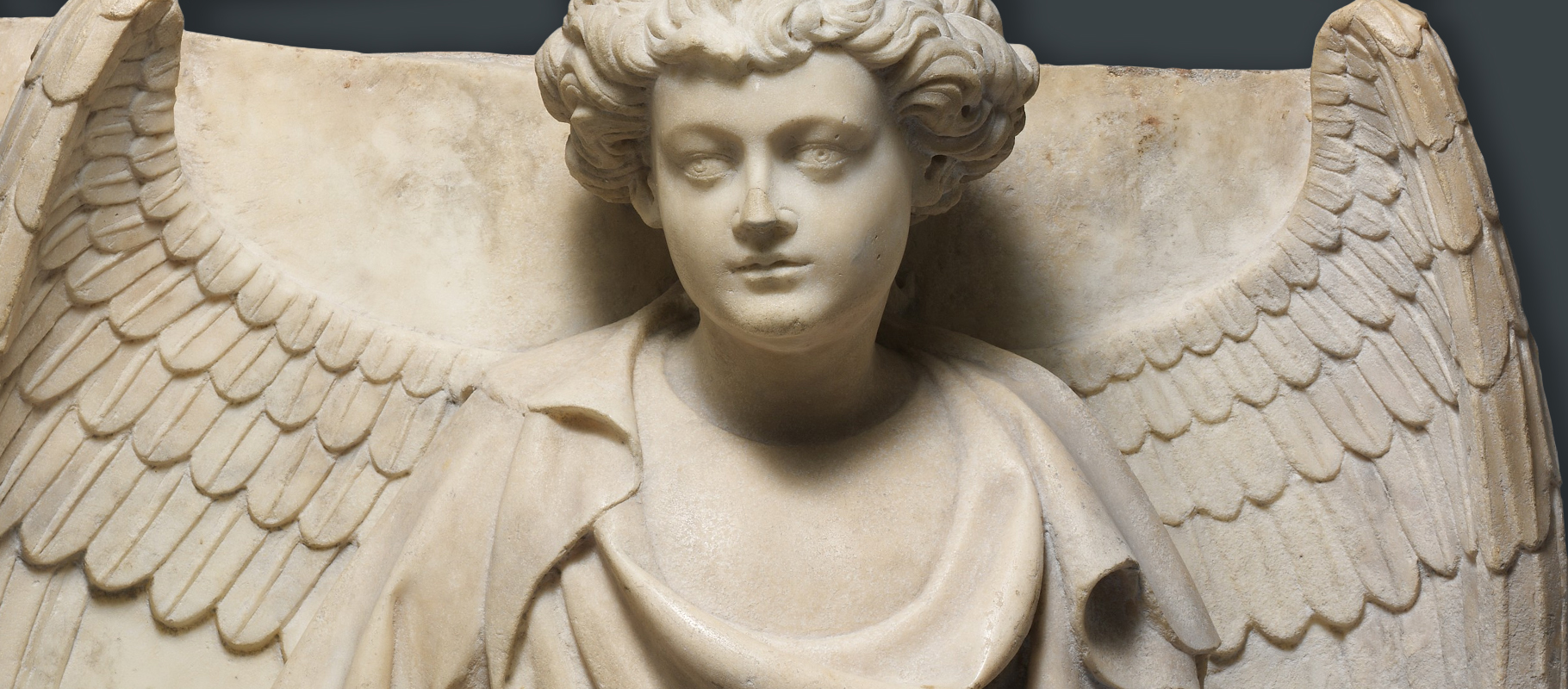 Above: an angel sculpted in Lunense marble from Carrara, 1430-35
Above: an angel sculpted in Lunense marble from Carrara, 1430-35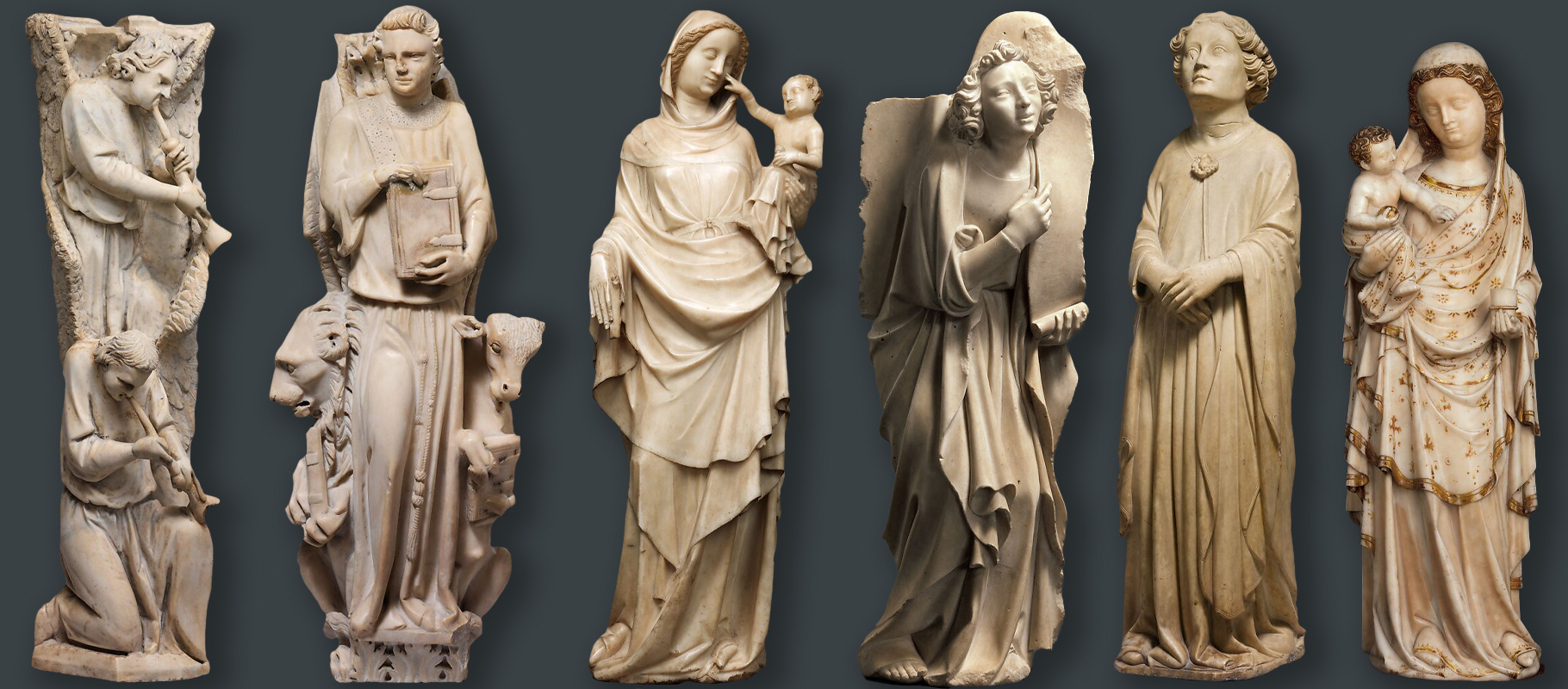 Above: from left to right, pilaster of angels from the parapet of a pulpit 1302-10, parapet tetramorph 1302-10, a South Netherlandish virgin and child 1345, an angel of the annunciation 1370-90, an adoring angel 1395–96, and a virgin and child with gilt details 1340
Above: from left to right, pilaster of angels from the parapet of a pulpit 1302-10, parapet tetramorph 1302-10, a South Netherlandish virgin and child 1345, an angel of the annunciation 1370-90, an adoring angel 1395–96, and a virgin and child with gilt details 1340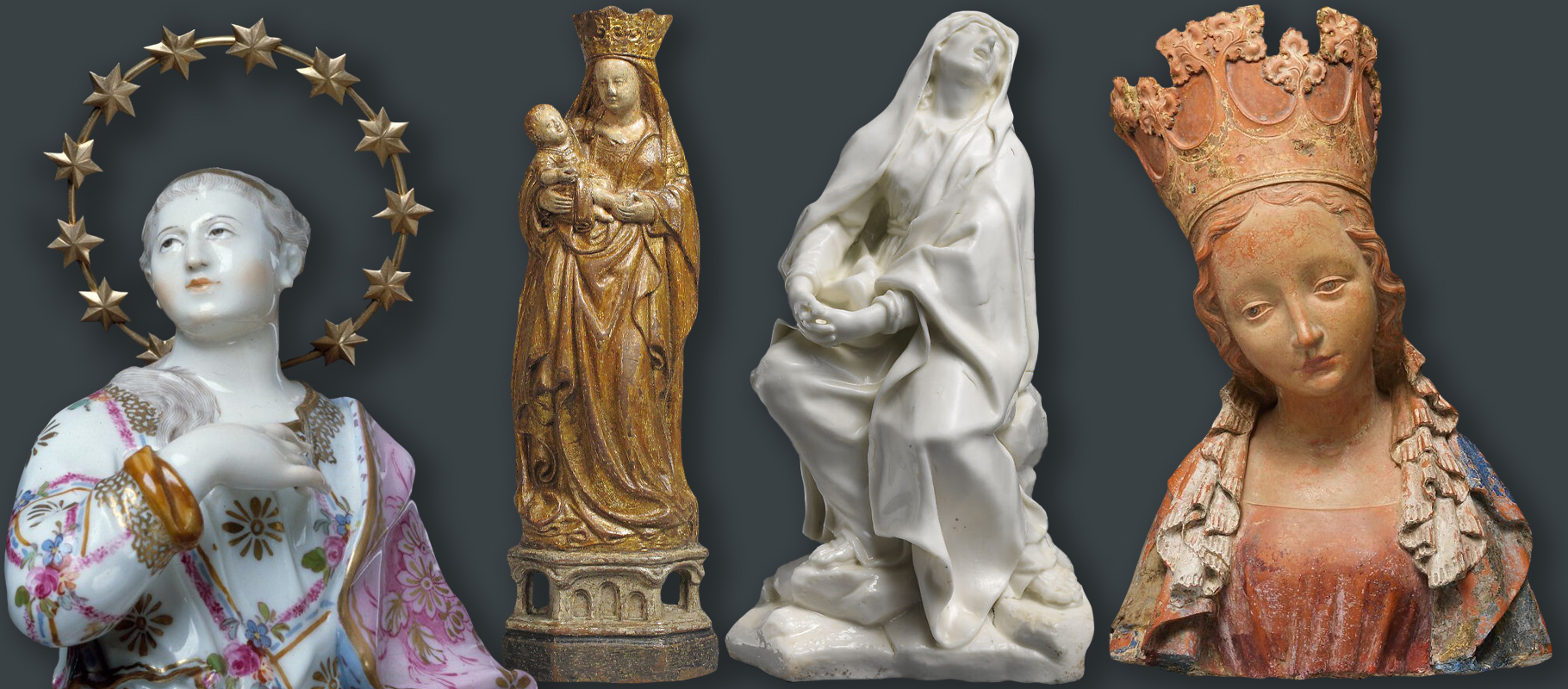 Above: from left to right, porcelain virgin mary by Fulda Pottery and Porcelain Manufactory 1781, a 15th century clay virgin with child, the mourning virgin by Capodimonte Porcelain Manufactory 1744, and a terracotta bust 1390-95
Above: from left to right, porcelain virgin mary by Fulda Pottery and Porcelain Manufactory 1781, a 15th century clay virgin with child, the mourning virgin by Capodimonte Porcelain Manufactory 1744, and a terracotta bust 1390-95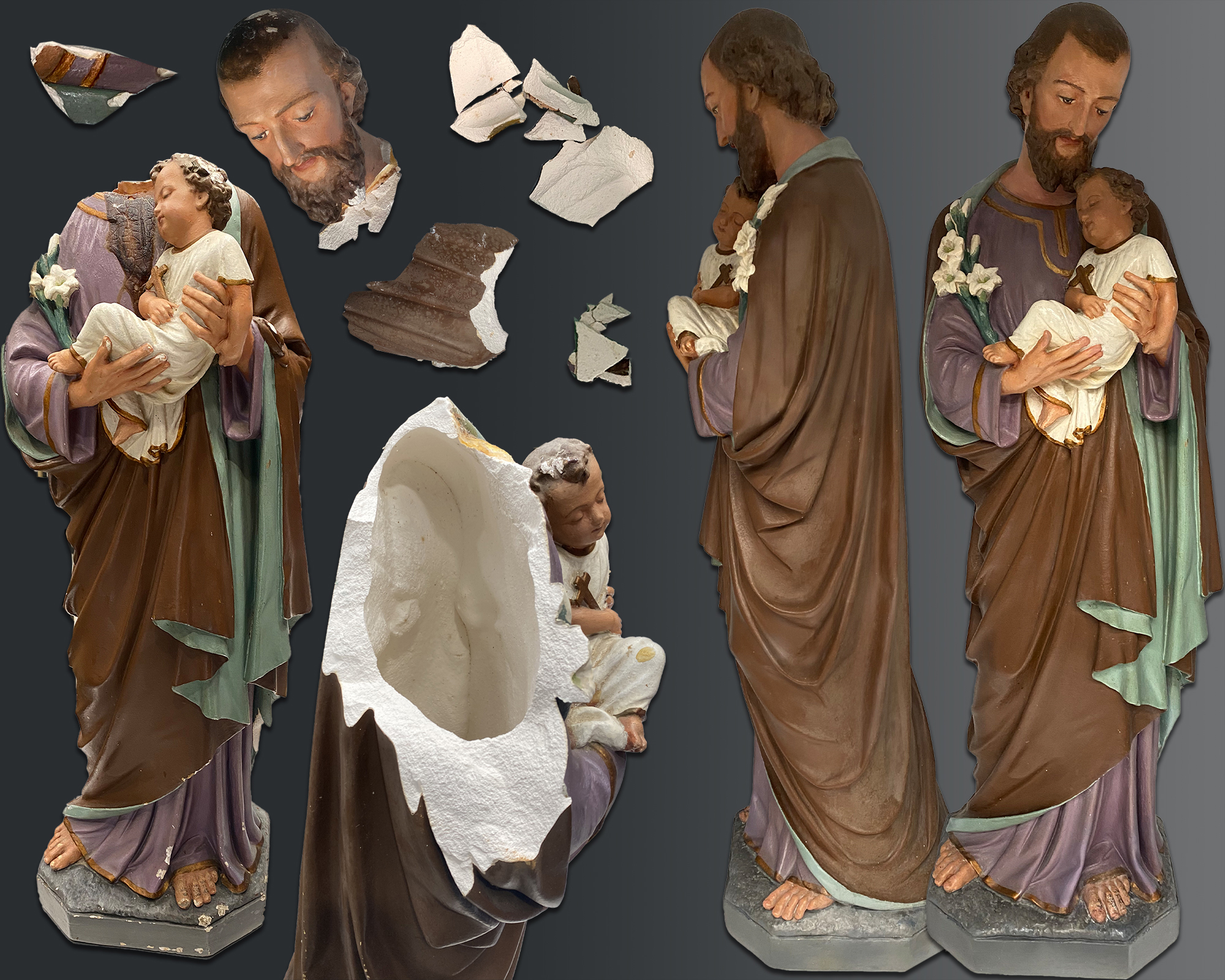 Above: a statue of St Joseph holding Christ, before and after restoration by our conservator
Above: a statue of St Joseph holding Christ, before and after restoration by our conservator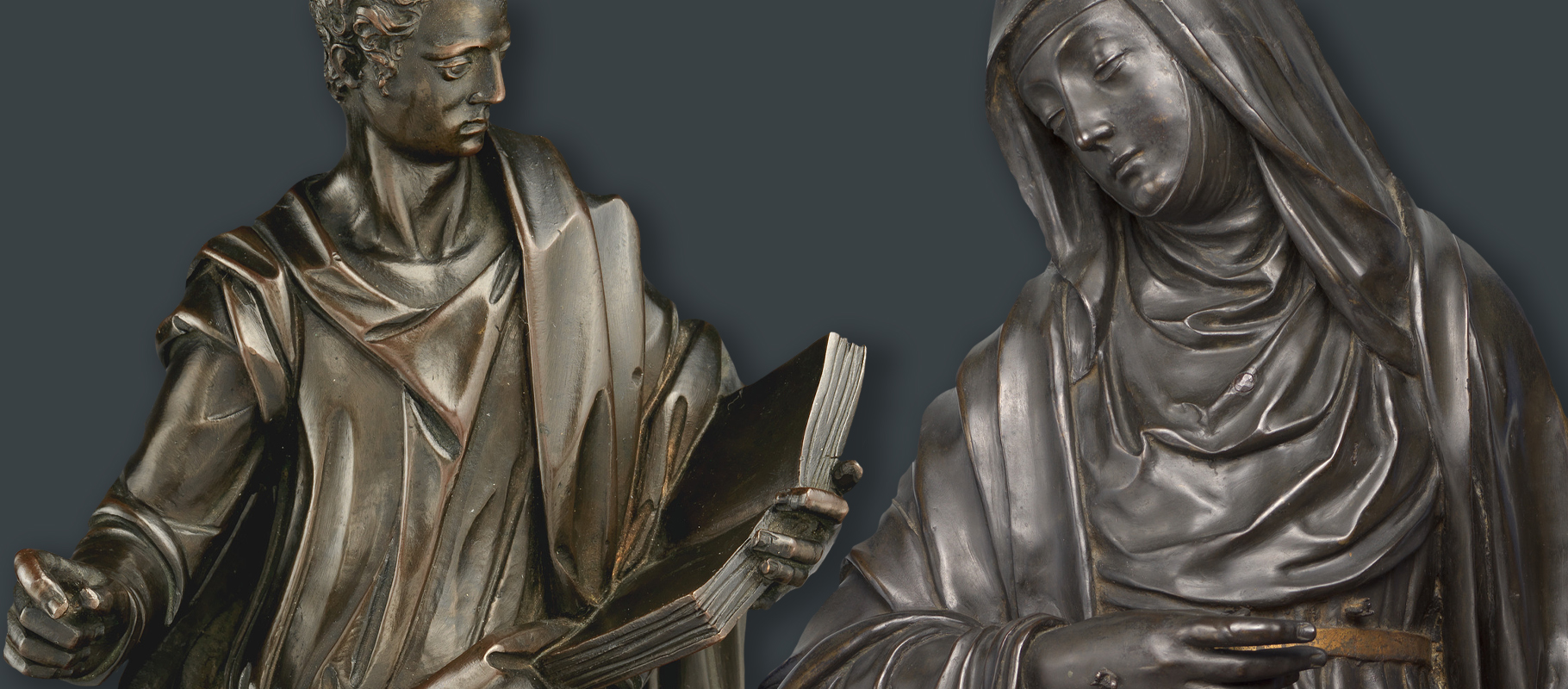 Above: an Italian bronze sculpture of Saint John from 1596 and a 17th century bronze cast of Saint Catherine of Siena with oil gilt details
Above: an Italian bronze sculpture of Saint John from 1596 and a 17th century bronze cast of Saint Catherine of Siena with oil gilt details




